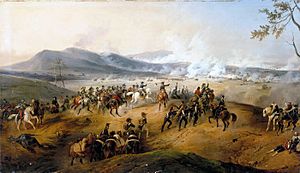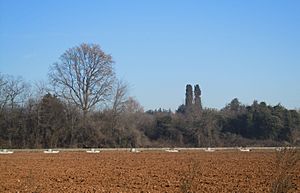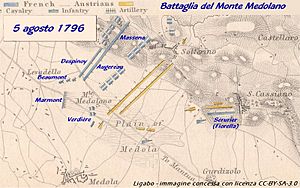Battle of Castiglione facts for kids
Quick facts for kids Second Battle of Castiglione |
|||||||
|---|---|---|---|---|---|---|---|
| Part of the Italian campaigns in the War of the First Coalition | |||||||
 5 August 1796, approximately 10 hours. Battle of Castiglione. Under the command of Napoleon, Marmont brings artillery onto Mount Medolano while Augereau's division begins the attack in the central plain. |
|||||||
|
|||||||
| Belligerents | |||||||
| Commanders and leaders | |||||||
| Strength | |||||||
| Battle: 30,000 | Battle: 25,000 | ||||||
| Casualties and losses | |||||||
| Battle: 1,300 | Battle: 3,000, 20 guns | ||||||
The Battle of Castiglione was a major fight during the French Revolutionary Wars. It happened on August 5, 1796, in northern Italy. The French army, led by the famous General Napoleon Bonaparte, fought against the Austrian army. The Austrians were commanded by General Dagobert Sigmund von Wurmser.
Even though the French army was smaller, they won the battle. The Austrians were forced to retreat across the Mincio River. This victory was very important for Napoleon. It was one of his four big wins during the War of the First Coalition. The town of Castiglione delle Stiviere is about 10 kilometers (6 miles) south of Lake Garda.
This battle was the first time the Austrian army tried to break the French siege of Mantua. Mantua was a very important fortress in northern Italy. Wurmser planned to attack the French from four different directions. Napoleon had to stop his siege of Mantua to face this threat. But Napoleon was very skilled and moved his troops quickly. He managed to keep the Austrian groups separated. This allowed him to defeat each group one by one over about a week.
Contents
Why the Battle Happened
After losing battles like Fombio and Lodi, the Austrian army retreated. They left about 14,000 soldiers to defend the fortress of Mantua. Mantua was one of four strong fortresses in the area. The French army already held the other three.
Napoleon tried to capture Mantua quickly on May 31, but he failed. So, on June 3, the French army began a formal siege of Mantua. This meant they surrounded the fortress and tried to starve out the defenders. Napoleon gathered many cannons to help with the siege.
Napoleon placed his 46,000 soldiers around Mantua to protect the siege. Different French generals were in charge of different areas. For example, André Masséna guarded the northern areas. Pierre Augereau covered the southern areas.
The Austrian commander, Wurmser, came up with a plan to break the siege. He divided his army into four groups, or "columns."
- Two main groups, led by Michael von Melas and Paul Davidovich, would attack from the center.
- One group, led by Peter Quasdanovich, would attack from the west of Lake Garda.
- Another group, led by Johann Mészáros von Szoboszló, would attack from the east.
How the Armies Moved
In late July, the Austrian army began to move. Wurmser's main groups defeated the French near Rivoli Veronese. At the same time, Quasdanovich's group pushed French soldiers out of Salò and Gavardo. On July 30, Quasdanovich's soldiers surprised and captured Brescia. This was a problem for Napoleon because Brescia was on his supply route.
Napoleon quickly reacted. He ordered his army to retreat to the west side of the Mincio River. He also told his general, Jean-Mathieu-Philibert Sérurier, to stop the siege of Mantua. This freed up more French soldiers to fight.
From July 31 to August 2, there were many smaller fights. Napoleon gathered his forces and recaptured Brescia on August 1. This secured his supply lines. Meanwhile, Wurmser's main groups reached Mantua. They spent time destroying the French siege equipment.
On August 2, an Austrian advance group captured Castiglione. The next day, Augereau's French troops attacked them. There was a tough fight, and the Austrians were pushed back. Wurmser then brought up his entire army and stopped Augereau's attack.
On August 3, the French won a big victory against Quasdanovich's group in the Battle of Lonato. This forced Quasdanovich to retreat north. With one Austrian group defeated, Napoleon now focused on Wurmser's main army. On August 4, both armies prepared for a major battle.
The Battle of Castiglione
By August 5, Wurmser had about 20,000 soldiers gathered at Castiglione. He set up his army in two lines. His right side was on high ground near Solferino. His left side was on a small hill called Monte Medolano, which had some cannons.
Napoleon had about 22,500 soldiers. He was also expecting more troops to arrive. Napoleon planned a clever attack. He would attack Wurmser from the front. At the same time, 5,000 French soldiers from Sérurier's group would attack the Austrian left side from behind. Once the Austrian lines were stretched out, Napoleon would launch a strong attack on Monte Medolano. This was a new tactic for Napoleon, called a "maneuver on the rear."
To trick Wurmser, Napoleon ordered his generals, Masséna and Augereau, to pretend to retreat. The Austrians followed them, thinking they were winning. Then, Sérurier's troops, led by General Pascal Antoine Fiorella, suddenly appeared and attacked the Austrian rear.
Wurmser had to quickly move his soldiers to stop this new threat. As the Austrians moved, Napoleon launched his main attack on Monte Medolano. Artillery, led by Auguste Marmont, fired at close range. French soldiers then stormed the hill.
While Masséna and Augereau attacked from the front, more French troops arrived. They captured Solferino. After fierce fighting, Wurmser realized his army was in danger of being surrounded. He ordered a retreat. The Austrians managed to cross the Mincio River that evening.
What Happened Next
The Austrians lost about 2,000 soldiers killed or wounded in the battle. They also lost 1,000 men and 20 cannons captured. The French lost between 1,100 and 1,500 soldiers.
Napoleon didn't want Wurmser to stay near Mantua. He made a fake attack with Augereau's group. But the real attack came from Masséna's group, which pushed back the Austrians. This forced Wurmser to retreat north towards Trento.
Before leaving, Wurmser sent more soldiers and much-needed food into Mantua. He also took out the sick soldiers. Napoleon then started the siege of Mantua again. But he didn't have his siege cannons anymore, so he could only try to blockade the fortress. This meant he would try to starve the defenders into surrendering.
In this whole campaign, the French lost about 6,000 soldiers killed or wounded. They also lost 4,000 men and their siege cannons captured. The Austrians lost a total of about 16,700 soldiers.
Images for kids





